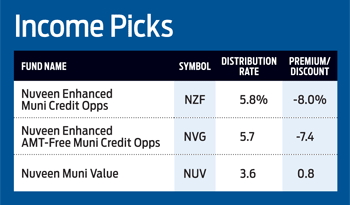Closed-End Muni Funds Offer Hefty Yields
Not impressed by the yields on your municipal bond mutual funds? Tax-sensitive income investors might find muni closed-end funds more rewarding.


Investors have been flocking to the relative safety and tax-free income of muni bonds, pouring nearly $40 billion in net new money into muni bond funds in the 12 months ending May 31. But such demand has pushed prices up and yields down: The average national intermediate-term municipal bond fund now yields less than 2.3%, according to investment-research firm Morningstar, down from about 2.5% in mid 2015.
Muni closed-end funds, however, offer a more tempting distribution rate—about 4.7%, on average. (The distribution rate is the annualized distribution divided by the share price.)
That juicier income comes with some unique advantages provided by the closed-end fund structure—but also some significant risks. A closed-end fund has a fixed number of shares that trade all day long on an exchange. That means their share prices can drift far from the value of their underlying holdings, whereas traditional mutual funds trade at the value of their portfolio holdings. And most muni closed-end funds use leverage, or borrowed money. “That’s going to boost returns when things are going well and can cause more severe drawdowns when things aren’t,” says Jason Kephart, an analyst at Morningstar.

Sign up for Kiplinger’s Free E-Newsletters
Profit and prosper with the best of expert advice on investing, taxes, retirement, personal finance and more - straight to your e-mail.
Profit and prosper with the best of expert advice - straight to your e-mail.
Like their traditional fund peers, muni closed-end funds have been popular lately. The average muni closed-end fund traded late last year at a more than 7% discount to the value of its underlying holdings; by June, that discount had narrowed to less than 0.1%, making it tougher to find bargains in this space.
And the ride for investors got a little rocky recently. In late May, fears of rising rates drove down muni closed-end fund share prices. In June, many muni closed-end funds cut distributions as longer-term rates fell and managers saw higher-yielding bonds called away.

Yet these vehicles still offer good opportunities for long-term investors who can stomach the risks, money managers and analysts say, and there are some attractive funds still trading at wide discounts.
The closed-end fund structure can be a particular advantage in the world of tax-free bonds because municipals tend to be less liquid—in other words, it can be costly to buy and sell them, especially in times of market turmoil. Unlike traditional fund managers, who have to deal with investor money flowing in and out of the fund every day, closed-end fund managers aren’t forced to buy or sell bonds based on fund flows.
Look Under the Fund’s Hood
To keep a lid on volatility, avoid those funds that are using much more leverage than their peers. Enter the fund’s name or ticker symbol in the quote box at Morningstar.com and look at the “total leverage ratio.” A 30% leverage ratio, for example, shows that for every $1 of investable capital, 30 cents is borrowed money.
Check out a fund’s ability to sustain steady payouts by clicking the “distribution” tab on the fund’s page at Morningstar.com or CEFconnnect.com. If recent payouts consist largely of “return of capital,” that means the fund is simply handing back your original investment in the form of a distribution—a big red flag.
Jim Robinson, manager of Robinson Tax Advantaged Income, a mutual fund that invests in muni closed-end funds, likes Nuveen Enhanced Municipal Credit Opportunities and Nuveen Enhanced AMT-Free Municipal Credit Opportunities. Both funds are still trading at wide discounts. Earlier this year, Nuveen merged six other muni closed-end funds into these two funds. That move benefits shareholders by reducing costs and by creating larger funds, which tend to be easier to trade and have narrower discounts, Robinson says.
Another large, liquid option is Nuveen Municipal Value, which gets a positive rating from Morningstar analysts. This Nuveen fund trades at a slight premium, but it uses very little leverage, making the fund a relatively stable option for conservative investors.
Profit and prosper with the best of Kiplinger's advice on investing, taxes, retirement, personal finance and much more. Delivered daily. Enter your email in the box and click Sign Me Up.

-
 I'm a Financial Strategist: This Is the Investment Trap That Keeps Smart Investors on the Sidelines
I'm a Financial Strategist: This Is the Investment Trap That Keeps Smart Investors on the SidelinesForget FOMO. FOGI — Fear of Getting In — is the feeling you need to learn how to manage so you don't miss out on future investment gains.
-
 Can You Be a Good Parent to an Only Child When You're Also a Business Owner?
Can You Be a Good Parent to an Only Child When You're Also a Business Owner?Author and social psychologist Susan Newman offers advice to business-owner parents on how to raise a well-adjusted single child by avoiding overcompensation and encouraging chores.
-
 457 Plan Contribution Limits for 2025
457 Plan Contribution Limits for 2025Retirement plans There are higher 457 plan contribution limits for state and local government workers in 2025. That's good news for state and local government employees.
-
 Medicare Basics: 12 Things You Need to Know
Medicare Basics: 12 Things You Need to KnowMedicare There's Medicare Part A, Part B, Part D, Medigap plans, Medicare Advantage plans and so on. We sort out the confusion about signing up for Medicare — and much more.
-
 The Seven Worst Assets to Leave Your Kids or Grandkids
The Seven Worst Assets to Leave Your Kids or Grandkidsinheritance Leaving these assets to your loved ones may be more trouble than it’s worth. Here's how to avoid adding to their grief after you're gone.
-
 SEP IRA Contribution Limits for 2025
SEP IRA Contribution Limits for 2025SEP IRA A good option for small business owners, SEP IRAs allow individual annual contributions of as much as $70,000 in 2025, up from $69,000 in 2024.
-
 Roth IRA Contribution Limits for 2025
Roth IRA Contribution Limits for 2025Roth IRAs Roth IRA contribution limits have gone up. Here's what you need to know.
-
 SIMPLE IRA Contribution Limits for 2025
SIMPLE IRA Contribution Limits for 2025simple IRA The SIMPLE IRA contribution limit increased by $500 for 2025. Workers at small businesses can contribute up to $16,500 or $20,000 if 50 or over and $21,750 if 60-63.
-
 457 Contribution Limits for 2024
457 Contribution Limits for 2024retirement plans State and local government workers can contribute more to their 457 plans in 2024 than in 2023.
-
 Roth 401(k) Contribution Limits for 2025
Roth 401(k) Contribution Limits for 2025retirement plans The Roth 401(k) contribution limit for 2025 increased, and workers who are 50 and older can save even more.